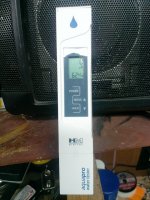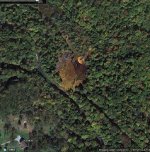k-bob
Well-known member
- Joined
- Jul 29, 2009
- Messages
- 2,373
Here is a simple conductivity gauge, about $40 on amazon, that can be useful in exploring streams in AMD areas. Conductivity is just electrical resistance of water. Conductivity can be interesting info in AMD areas, because AMD inputs can release metals such as aluminum into streams, harming or even wiping out trout. AMD inputs are local inputs; one stream can be trout-free - such as buck mountain or sandy run in carbon cty (link below) - while nearby streams have low or trout-tolerable AMD and conductivity levels. Conductivity gauges are simpler and cheaper than pH gauges. Also, AMD has a more direct effect on conductivity than pH.
Good way to use the meter is to get a quick conductivity level when exploring possible AMD areas and compare to nearby streams at similar flow levels. Stream looks fishy but you don't find any trout and the conductivity is highly elevated, time to move on...
> "AMD pollution produces noticeably elevated conductivity
readings since the dissolved metals, sulfate, and hydrogen ions can all conduct a charge." "Conductivity bridges (or meters) are rugged pieces of equipment and very useful in the field as they are quick and easy to use." good source:
http://tinyurl.com/k5edufy
also
http://tinyurl.com/pcsp29t
> there are regional conductivity tendencies, so you have to compare nearby streams
> AMD discharges are more constant than rainwater inputs, so conductivity will tend to read higher at low flow (for ex summer vs spring)
> some streams with trout-lethal AMD are known and can be comparison streams. for example, in the anthracite region:
http://tinyurl.com/k4vm65a
> conductivity can also show acidity release from snowmelt affected by acid rain (see data this spring for indiantown run w/ conductivity info and apparent snowmelt spike)
http://tinyurl.com/lskoxod
> good to buy an 84 muS calibration solution for the gauge to verify its tuning and calibrate if needed. also, like everything else , it's on amazon.
, it's on amazon.
> like a lot of things, have to try it and read up a bit.
Good way to use the meter is to get a quick conductivity level when exploring possible AMD areas and compare to nearby streams at similar flow levels. Stream looks fishy but you don't find any trout and the conductivity is highly elevated, time to move on...
> "AMD pollution produces noticeably elevated conductivity
readings since the dissolved metals, sulfate, and hydrogen ions can all conduct a charge." "Conductivity bridges (or meters) are rugged pieces of equipment and very useful in the field as they are quick and easy to use." good source:
http://tinyurl.com/k5edufy
also
http://tinyurl.com/pcsp29t
> there are regional conductivity tendencies, so you have to compare nearby streams
> AMD discharges are more constant than rainwater inputs, so conductivity will tend to read higher at low flow (for ex summer vs spring)
> some streams with trout-lethal AMD are known and can be comparison streams. for example, in the anthracite region:
http://tinyurl.com/k4vm65a
> conductivity can also show acidity release from snowmelt affected by acid rain (see data this spring for indiantown run w/ conductivity info and apparent snowmelt spike)
http://tinyurl.com/lskoxod
> good to buy an 84 muS calibration solution for the gauge to verify its tuning and calibrate if needed. also, like everything else
> like a lot of things, have to try it and read up a bit.






